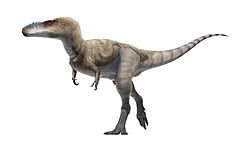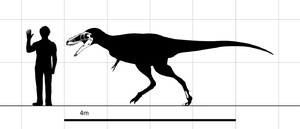Alioramus facts for kids
Quick facts for kids Alioramus |
|
|---|---|
 |
|
| Alioramus remotus | |
| Scientific classification | |
| Kingdom: | |
| Class: | |
| Superorder: | |
| Order: | |
| Suborder: | |
| Superfamily: |
†Tyrannosauroidea
|
| Family: | |
| Subfamily: |
†Tarbosaurinae
|
| Tribe: |
†Alioramini
|
| Genus: |
†Alioramus
|
| Type species | |
| Alioramus remotus Kurzanov, 1979
|
|
| Species | |
|
†A. remotus Kurzanov, 1976 |
|
| Synonyms | |
|
Genus synonymy
Qianzhousaurus
Lü et al., 2014 |
|
Alioramus (say: Ah-lee-oh-RAY-mus) was a type of tyrannosaurid dinosaur that lived in Asia. These dinosaurs roamed the Earth during the Late Cretaceous period, about 70 million years ago.
The first Alioramus fossils were found in Mongolia. These included parts of a skull and some foot bones. A Soviet scientist named Sergei Kurzanov described them in 1976. Later, in 2009, another species called A. altai was found. This discovery gave scientists a much more complete skeleton to study.
Like other theropod dinosaurs, Alioramus walked on two legs. Its sharp teeth tell us it was a carnivore, meaning it ate meat. Alioramus was smaller than famous tyrannosaurids like Tarbosaurus or Tyrannosaurus rex. Scientists believe the known Alioramus fossils are from young dinosaurs, so adult Alioramus might have been bigger.
Alioramus had some unique features. It had a row of five bony crests along the top of its snout. It also had more teeth than any other tyrannosaurid and a lower, more slender skull.
Contents
Discovering Alioramus
The first Alioramus species, A. remotus, was found in Mongolia. These fossils were discovered in an area that was once a wet floodplain. This means the dinosaur lived in a marshy or riverside environment.
In 2009, a second species, A. altai, was found. This discovery was very exciting because its skeleton was much more complete. It helped scientists learn a lot more about this unique dinosaur.
A possible third species, A. sinensis, was described in 2014. Its fossils were found in China.
What Did Alioramus Look Like?
When A. remotus was first described, scientists thought it was about 5 to 6 meters (16 to 20 feet) long. However, the skull was squashed during fossilization, which might have made it seem longer than it was. If the known specimens are young, adult Alioramus could have been larger.
A Unique Skull
The skull of A. remotus was about 45 centimeters (18 inches) long. It was long and low, which is typical for younger tyrannosaurids or older types of tyrannosaurs.
One of the most special features of Alioramus was the five bony crests on its snout. These crests were more than 1 centimeter (0.4 inches) tall and stuck up from its nose bones.
At the back of its skull, Alioramus had a thick bony ridge called the nuchal crest. This feature is found in all tyrannosaurids.
Many Teeth!
The lower jaw of Alioramus was also long and slender. Alioramus had 76 or 78 teeth. This is more teeth than any other known tyrannosaurid!
Most of the A. remotus skeleton is still unknown, except for some foot bones. But the discovery of A. altai has given scientists a much better idea of what the rest of this dinosaur looked like.
Images for kids
-
Cretaceous-aged dinosaur fossil localities of Mongolia; Alioramus has been collected in area A (left)
See also
 In Spanish: Alioramus para niños
In Spanish: Alioramus para niños






